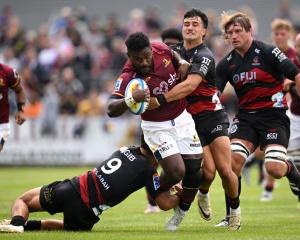The University A side has plenty of talent on the field but is also getting some help from GPS (Global Positioning System) devices worn by players.
The devices, which are commonly used by National Rugby League teams during training and playing, record distances and areas covered during a game, players' speed and the force generated in tackles.
They are used by many Super 14 sides, including the Highlanders, but University A has taken the next step for a club team by using the devices in games.
The team's conditioning coach, Matt Blair, who in 2007 used GPS technology while doing a study on Super 14 referees for his master's degree in physical education, said it was a useful training tool, and meant players could not "hide".
"We can tell how much work some guys are doing and whether he is reaching his top speed enough. For someone like a winger, it can show how often during a game they reach that top velocity. And from that we can structure our training and work out what needs to be done," Blair said.
"It takes a lot of bias out of things. Guys can't really hide now and make a couple of runs during the game and might think they have had a good game. And it is so much more efficient than what they used to have."
The devices are tucked into a shoulder strap and sit between a player's shoulder blades. The team did not seek permission to use them during matches, and Blair said they were harmless.
Previously, for major games, cameras were positioned around the field, and it would take up to three days for a handful of people to gather all the data. Blair said he could gather this information in a couple of minutes after the end of the game.
He said inside backs covered the most territory in the game, though there were many variables when it came to distances covered.
"Outside backs do actually cover a lot of ground, sometimes up to 10km a game, as they are always doing a lot of covering and repositioning."
He said the data could help in the structure of practices.
"We might look at a winger and think `this guy needs to be running a wee bit quicker' after getting the data from a game. So we will gear our practice around that."
The gear was not worn by the front-rowers, and not at every practice. Blair said the devices were just pieces of training equipment to help players.
"It is a good tool but that is only what it is, a tool.
"I'm a great believer in giving the platforms to these guys to play at their best capabilities. But they still have to go out and play rugby.
"We don't want guys being taken over by it. Playing the game is still the key thing."
University A coach John Leslie said the tool definitely helped, and he could see what players were doing well and when as a coach it was time to crack the whip.
Blair has worked with International Rugby Board referee manager Paddy O'Brien, as most international referees use the devices.
He has also been picked by the IRB to help with conditioning programmes in Fiji, Samoa and Tonga in July and September this year. He will take the GPS devices to the Pacific Islands.












